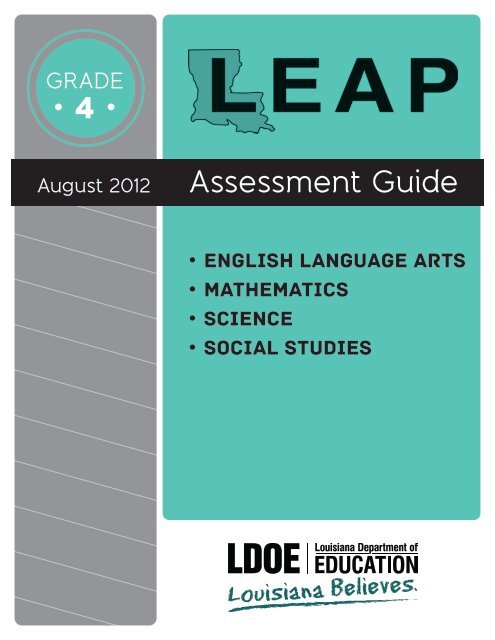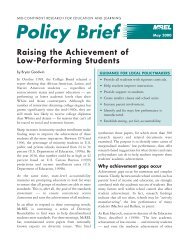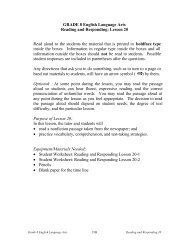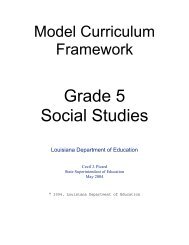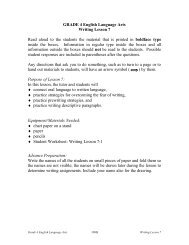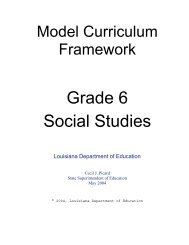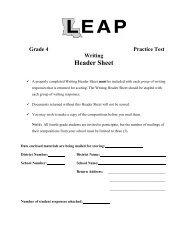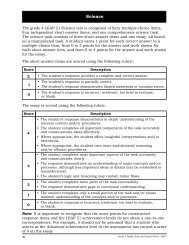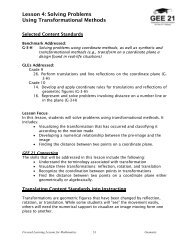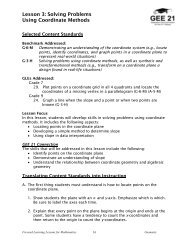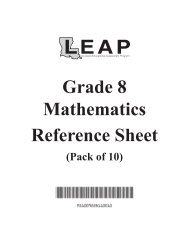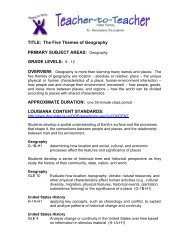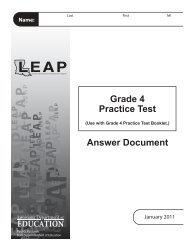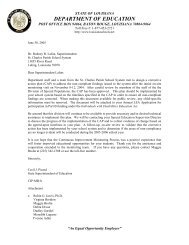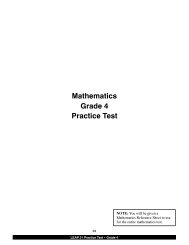Preface - Louisiana Department of Education
Preface - Louisiana Department of Education
Preface - Louisiana Department of Education
You also want an ePaper? Increase the reach of your titles
YUMPU automatically turns print PDFs into web optimized ePapers that Google loves.
GRADE<br />
• 4 •<br />
August 2012<br />
Assessment Guide<br />
• ENGLISH LANGUAGE ARTS<br />
• MATHEMATICS<br />
• SCIENCE<br />
• SOCIAL STUDIES
<strong>Louisiana</strong> State Board <strong>of</strong> Elementary and Secondary <strong>Education</strong><br />
Ms. Penny Dastugue<br />
President<br />
Member-at-Large<br />
Mr. Charles E. Roemer<br />
Vice President<br />
Sixth BESE District<br />
Mr. James D. Garvey, Jr.<br />
Secretary-Treasurer<br />
First BESE District<br />
Ms. Kira Orange Jones<br />
Second BESE District<br />
Ms. Lottie P. Beebe<br />
Third BESE District<br />
Mr. Walter Lee<br />
Fourth BESE District<br />
Mr. Jay Guillot<br />
Fifth BESE District<br />
Ms. Catherine Pozniak<br />
Executive Director<br />
Ms. Holly B<strong>of</strong>fy<br />
Seventh BESE District<br />
Ms. Carolyn Hill<br />
Eighth BESE District<br />
Mr. John L. Bennett<br />
Member-at-Large<br />
Ms. Connie Bradford<br />
Member-at-Large<br />
The mission <strong>of</strong> the <strong>Louisiana</strong> <strong>Department</strong> <strong>of</strong> <strong>Education</strong> (LDOE) is to ensure equal access to education and to promote equal excellence<br />
throughout the state. The LDOE is committed to providing Equal Employment Opportunities and is committed to ensuring that all its<br />
programs and facilities are accessible to all members <strong>of</strong> the public. The LDOE does not discriminate on the basis <strong>of</strong> age, color, disability,<br />
national origin, race, religion, sex, or genetic information. Inquiries concerning the LDOE’s compliance with Title IX and other civil rights<br />
laws may be directed to the Attorney, LDOE, Office <strong>of</strong> the General Counsel, P.O. Box 94064, Baton Rouge, LA 70804-9064; 877-453-2721<br />
or customerservice@la.gov. Information about the federal civil rights laws that apply to the LDOE and other educational institutions is<br />
available on the website for the Office <strong>of</strong> Civil Rights, USDOE, at http://www.ed.gov/about/<strong>of</strong>fices/list/ocr/.<br />
This public document was published at a total cost <strong>of</strong> $6,000.00. This web-only document was published for the <strong>Louisiana</strong> <strong>Department</strong> <strong>of</strong><br />
<strong>Education</strong>, Office <strong>of</strong> Standards, Assessments, and Accountability, Division <strong>of</strong> Assessments and Accountability, P.O. Box 94064, Baton<br />
Rouge, LA 70804-9064, by Data Recognition Corporation, 13490 Bass Lake Road, Maple Grove, MN 55311. This material was published in<br />
accordance with the standards for printing by state agencies established pursuant to R.S. 43:31 and in accordance with the provisions <strong>of</strong> Title<br />
43 <strong>of</strong> the <strong>Louisiana</strong> Revised Statutes.<br />
For further information, contact:<br />
<strong>Louisiana</strong> <strong>Department</strong> <strong>of</strong> <strong>Education</strong>'s Help Desk<br />
1-877-453-2721<br />
Ask LDOE?<br />
http://www.louisianaschools.net/<strong>of</strong>fices/publicaffairs/ask.aspx<br />
© 2012, <strong>Louisiana</strong> <strong>Department</strong> <strong>of</strong> <strong>Education</strong>
Table <strong>of</strong> Contents<br />
<strong>Preface</strong><br />
What is the purpose <strong>of</strong> the Assessment Guide? ......................................................... v<br />
Why has the Assessment Guide been revised? .......................................................... v<br />
How will students and teachers transition to the CCSS and PARCC? ...................... vi<br />
What is the purpose <strong>of</strong> the LEAP? ............................................................................ vii<br />
What Does the Assessment Guide Include? ............................................................... vii<br />
General LEAP Test Design ........................................................................... vii<br />
Characteristics <strong>of</strong> Items ................................................................................. ix<br />
Administration Schedule ............................................................................... ix<br />
Achievement Levels ...................................................................................... x<br />
Test Accommodations ................................................................................... xi<br />
What additional LEAP resources are available? ....................................................... xii<br />
Chapter 1: LEAP English Language Arts, Grade 4<br />
Test Structure and Item Types ................................................................................... 1-1<br />
Scoring the English Language Arts Sessions .......................................................... 1-3<br />
Standards and Benchmarks Assessed ...................................................................... 1-13<br />
Writing ......................................................................................................... 1-14<br />
Reading and Responding .............................................................................. 1-16<br />
Using Information Resources ...................................................................... 1-18<br />
Pro<strong>of</strong>reading ................................................................................................ 1-19<br />
Sample Test Items: Grade 4 English Language Arts ............................................... 1-20<br />
Chapter 2: LEAP Mathematics, Grade 4<br />
Test Structure ........................................................................................................... 2-1<br />
Item Types and Scoring Information ......................................................................... 2-1<br />
Description <strong>of</strong> the Mathematics Test and GLEs Assessed ...................................... 2-2<br />
Reporting Categories ............................................................................................... 2-4<br />
Mathematics Test Specifications ............................................................................. 2-4<br />
Calculator Recommendations and Restrictions ....................................................... 2-5<br />
Sample Test Items: Grade 4 Mathematics .............................................................. 2-6<br />
Chapter 3: LEAP Science, Grade 4<br />
Test Structure ........................................................................................................... 3-1<br />
Item Types ... ........................................................................................................... 3-1<br />
Test Description ....................................................................................................... 3-2<br />
Scoring the Science Sessions .................................................................................. 3-2<br />
Science Test Specifications, Grade 4 ...................................................................... 3-4<br />
Strands, Standards, Benchmarks, and Dimensions Assessed ................................. 3-5<br />
Science as Inquiry ....................................................................................... 3-8<br />
Physical Science ......................................................................................... 3-10<br />
Life Science ................................................................................................ 3-13<br />
Earth and Space Science ............................................................................. 3-16<br />
Science and the Environment ..................................................................... 3-19<br />
i
Sample Test Items: Grade 4 Science ...................................................................... 3-22<br />
Benchmark Statements, across Grades ................................................................... 3-46<br />
Science Achievement Level Descriptors: Grade 4 ................................................. 3-63<br />
Chapter 4: LEAP Social Studies, Grade 4<br />
Test Structure ........................................................................................................... 4-1<br />
Item Types ... ........................................................................................................... 4-1<br />
Test Description ...................................................................................................... 4-1<br />
Scoring the Social Studies Sessions ......................................................................... 4-2<br />
Social Studies Test Specifications, Grade 4 ............................................................ 4-3<br />
Strands, Standards, and Benchmarks Assessed ....................................................... 4-4<br />
Strand G: Geography .................................................................................. 4-6<br />
Strand C: Civics .......................................................................................... 4-13<br />
Strand E: Economics ................................................................................... 4-17<br />
Strand H: History ........................................................................................ 4-21<br />
Sample Test Items: Grade 4 Social Studies ............................................................. 4-26<br />
Standards and Benchmarks, across Grades ............................................................ 4-52<br />
Social Studies Achievement Level Descriptors: Grade 4 ………………………... 4-75<br />
Appendices<br />
Appendix A: Glossary ............................................................................................. A-1<br />
Appendix B: LEAP Frequently Asked Questions ..................................................... B-1<br />
Appendix C: Testing Special Populations ................................................................ C-1<br />
Appendix D: Writer’s Checklist and Mathematics Reference Sheet ....................... D-1<br />
ii
List <strong>of</strong> Tables<br />
<strong>Preface</strong><br />
Table 1: Assessment Implementation Plan ................................................................ vi<br />
Table 2: Overall Design <strong>of</strong> the LEAP ........................................................................ viii<br />
Table 3: Phase 1 Components <strong>of</strong> the LEAP ............................................................. ix<br />
Table 4: Phase 2 Components <strong>of</strong> the LEAP .............................................................. x<br />
Chapter 1: LEAP English Language Arts, Grade 4<br />
Table 1.1: English Language Arts Test Specifications, Grade 4 ............................... 1-3<br />
Table 1.2: Example <strong>of</strong> Scores for the Written Composition ..................................... 1-11<br />
Table 1.3: General Scoring Guide (Rubric)—Short-Answer Items .......................... 1-12<br />
Table 1.4: Examples <strong>of</strong> English Language Arts Codes ............................................. 1-13<br />
Chapter 2: LEAP Math, Grade 4<br />
Table 2.1: Suggested Testing Times .......................................................................... 2-1<br />
Table 2.2: GLE Content To Be Taught and Tested in 2012–13 and 2013–14 .......... 2-3<br />
Table 2.3: Grade 4 Mathematics Reporting Categories ............................................. 2-4<br />
Table 2.4: Grade 4 Mathematics Test Specifications ................................................ 2-4<br />
Chapter 3: LEAP Science, Grade 4<br />
Table 3.1: General Scoring Rubric—Short-Answer Items ............................................. 3-3<br />
Table 3.2: General Scoring Rubric—Extended Constructed-Response Items ............... 3-3<br />
Table 3.3: Number <strong>of</strong> Multiple-Choice, Short-Answer, and Extended<br />
Constructed-Response Items by Strand ......................................................... 3-4<br />
Chapter 4: LEAP Social Studies, Grade 4<br />
Table 4.1: General Scoring Rubric—Constructed-Response Items .......................... 4-2<br />
Table 4.2: Number <strong>of</strong> Multiple-Choice Items in Strands/Categories ........................ 4-3<br />
Table 4.3: Examples <strong>of</strong> Social Studies Codes ........................................................... 4-5<br />
iii
This Assessment Guide may be distributed in its entirety to all teachers. However,<br />
schools may choose to provide the specific content chapters to teachers who are<br />
responsible for each content area.<br />
All teachers should be provided with the following sections <strong>of</strong> the Assessment<br />
Guide:<br />
• <strong>Preface</strong><br />
• Appendices A, B, C, and D, which include a glossary, frequently asked<br />
questions, information about testing special populations, a Writer’s Checklist,<br />
and a Mathematics Reference Sheet.<br />
<strong>Preface</strong><br />
<strong>Louisiana</strong> Believes embraces the principle that all children can achieve at high levels, as<br />
evidenced in <strong>Louisiana</strong>’s recent adoption <strong>of</strong> the Common Core State Standards (CCSS).<br />
<strong>Louisiana</strong> Believes also promotes the idea that <strong>Louisiana</strong>’s educators should be empowered to<br />
make decisions to support the success <strong>of</strong> their students. In keeping with these values, the<br />
<strong>Department</strong> has created transitional assessment guides to help prepare teachers and students as<br />
they transition to the new CCSS over the next two years. These guides reflect the State’s<br />
commitment to consistent and rigorous assessments and provide educators and families with<br />
clear information about expectations for student performance.<br />
What is the purpose <strong>of</strong> the Assessment Guide?<br />
The LEAP Assessment Guide provides an overview <strong>of</strong> <strong>Louisiana</strong> assessments administered<br />
through the <strong>Louisiana</strong> <strong>Education</strong>al Assessment Program (LEAP). In addition to providing<br />
teachers with a description <strong>of</strong> the overall design <strong>of</strong> the LEAP tests, this guide presents sample<br />
test items and suggested informational resources.<br />
Teachers should use this guide to:<br />
• become familiar with the LEAP test format,<br />
• include similar item formats in classroom instruction and assessments,<br />
• align instruction and assessment with the <strong>Louisiana</strong> Comprehensive Curriculum and<br />
Grade-Level Expectations (GLEs), and<br />
• provide appropriate test accommodations.<br />
Questions regarding this Assessment Guide should be addressed to the Division <strong>of</strong> Assessments<br />
and Accountability, <strong>Louisiana</strong> <strong>Department</strong> <strong>of</strong> <strong>Education</strong> (LDOE), at 225-342-3393 or toll free at<br />
1-877-453-2721.<br />
Why has the Assessment Guide been revised?<br />
In 2010, the Board <strong>of</strong> Elementary and Secondary <strong>Education</strong> (BESE) approved the Common Core<br />
State Standards (CCSS) (http://www.doe.state.la.us/topics/common_core.html), which will<br />
eventually replace <strong>Louisiana</strong>’s English language arts (ELA) and mathematics standards and<br />
GLEs. After adopting the CCSS, <strong>Louisiana</strong> became a governing member <strong>of</strong> a 24-state<br />
LEAP Assessment Guide v <strong>Preface</strong>
consortium—the Partnership for Assessment <strong>of</strong> Readiness for College and Careers (PARCC)—<br />
working to develop next-generation assessments that measure the full range <strong>of</strong> the CCSS. In<br />
preparation for the PARCC assessments, which are to be administered starting in the 2014–2015<br />
school year, the <strong>Department</strong> has created transitional assessments in ELA and mathematics. This<br />
revised guide provides information about the changes to LEAP during the transition to the<br />
CCSS.<br />
It is important to note that the LEAP Science and Social Studies tests have not changed.<br />
The content standards and benchmarks that form the basis for these tests have not<br />
changed. Rather, the format and the organization <strong>of</strong> the guides have been revised to reflect<br />
the ELA and mathematics transition to the CCSS, and the text has been edited for<br />
conciseness.<br />
How will students and teachers transition to the CCSS and PARCC?<br />
The state has developed an implementation plan to ease the transition to the more rigorous new<br />
standards and assessments. This plan, outlined below, includes two years <strong>of</strong> implementation <strong>of</strong><br />
transitional curriculum and assessments. Full implementation <strong>of</strong> the CCSS and PARCC<br />
assessments will occur in the 2014–2015 school year. Table 1 provides an overview <strong>of</strong> the<br />
assessment plan for grades 3–8.<br />
Table 1: Assessment Implementation Plan<br />
2012–2013 2013–2014 2014–2015<br />
Transitional Transitional PARCC<br />
2012–2013 and 2013–2014: Transition Years – The transitional LEAP assessments will be<br />
administered during the spring <strong>of</strong> 2013 and the spring <strong>of</strong> 2014. These assessments are not<br />
designed to be more difficult than the current LEAP assessments, but teachers will need to shift<br />
their instruction for their students to be fully prepared.<br />
The LEAP tests administered through the 2011–2012 school year measured the knowledge and<br />
skills contained in the state’s content standards and benchmarks that are clustered by grades K–4<br />
in the grade 4 LEAP assessments and grades 5–8 in the grade 8 LEAP assessments. The LEAP<br />
ELA tests will continue to measure the skills presented in these clusters, but the writing prompts<br />
on the transitional assessments will be a new type <strong>of</strong> prompt that focuses on a key instructional<br />
shift—writing grounded in textual evidence. Instead <strong>of</strong> responding to a “stand alone” writing<br />
prompt, students will read one or two passages and use the information from the text(s) to<br />
support the response. The Reading and Responding, Using Information Resources, and<br />
Pro<strong>of</strong>reading components will continue to be assessed in the same way.<br />
The grade 4 LEAP mathematics transitional assessments will change to only include items that<br />
measure content common to the grade 4 GLEs and the CCSS<br />
(http://www.louisianaschools.net/topics/gle.html).<br />
LEAP Assessment Guide vi <strong>Preface</strong>
2014–2015: Full Implementation – The new PARCC assessments for the LEAP grades will be<br />
administered starting in the spring <strong>of</strong> 2015. The CCSS will replace the GLEs in ELA and<br />
mathematics.<br />
What is the purpose <strong>of</strong> the LEAP?<br />
Through the LEAP, students are able to demonstrate what they know about a content area, as<br />
well as their mastery <strong>of</strong> the standards, benchmarks, and GLEs, to help educators determine how<br />
students are progressing in relation to the content standards from year to year. The LEAP tests<br />
remain high stakes for students in grades 4 and 8 because they are tied to promotional policy.<br />
The high-stakes testing policy can be accessed at http://www.doe.state.la.us/testing/.<br />
The LEAP assessments are part <strong>of</strong> the testing program that complies with the requirements <strong>of</strong> the<br />
No Child Left Behind Act (NCLB), the federal act that requires states to administer tests in<br />
reading and mathematics: yearly in grades 3 through 8 and once in grades 10 through 12, as well<br />
as in science: once in grades 3 through 5, once in grades 6 through 9, and once in grades 10<br />
through 12. Some <strong>of</strong> the NCLB requirements are met through <strong>Louisiana</strong>’s iLEAP tests in ELA,<br />
mathematics, and science at grades 3, 5, 6, and 7 and by End-<strong>of</strong>-Course (EOC) high school<br />
assessments.<br />
NCLB requires that state assessments be aligned to state content standards. In addition, NCLB<br />
requires that states express student results in terms <strong>of</strong> the state’s performance standards—<br />
<strong>Louisiana</strong>’s achievement levels. The LEAP assessments, which are given at grades 4 and 8, have<br />
been developed to align to the <strong>Louisiana</strong> content standards, benchmarks, and GLEs.<br />
What Does the Assessment Guide Include?<br />
The Assessment Guide provides information for teachers regarding the purpose and structure <strong>of</strong><br />
the LEAP. Separate guides are available for both <strong>of</strong> the LEAP grade levels: 4 and 8. The guides<br />
include information about:<br />
• test design (format and blueprints),<br />
• test content,<br />
• sample test items, and<br />
• scoring.<br />
General LEAP Test Design<br />
The LEAP includes multiple-choice and constructed-response items. Table 2 presents the overall<br />
design (test components) <strong>of</strong> the LEAP for each <strong>of</strong> the content areas assessed. It presents the<br />
approximate number <strong>of</strong> items for each test and the item types, indicated by multiple-choice (MC)<br />
and constructed-response (CR).<br />
LEAP Assessment Guide vii <strong>Preface</strong>
Table 2: Overall Design <strong>of</strong> the LEAP<br />
CONTENT AREA<br />
English Language Arts<br />
(Grades 4 and 8)<br />
Mathematics<br />
(Grades 4 and 8)<br />
Science<br />
(Grades 4 and 8)<br />
Social Studies<br />
(Grades 4 and 8)<br />
TEST SESSIONS<br />
• Writing (in response to a text-based prompt)<br />
• Reading and Responding<br />
o 4 reading passages: 2 short/2 long<br />
o 4 to 6 MC items (1 point each) per passage<br />
o 2 CR (short-answer) items (2 points each) per passage<br />
o Grade 8 only: one extended CR item (4 points)<br />
• Using Information Resources<br />
o One resource packet with 4 to 6 sources<br />
o 5 MC items and 2 CR (short-answer) items<br />
• Pro<strong>of</strong>reading<br />
o One short passage<br />
o 8 MC items<br />
• 60 MC items<br />
Grade 4:<br />
o 36 noncalculator<br />
o 24 calculator<br />
o Problem-solving context<br />
Grade 8:<br />
o 30 noncalculator<br />
o 30 calculator<br />
o Problem-solving context<br />
• Extended CR items (4 points)<br />
o Grade 4: 3 items<br />
o Grades 8: 4 items<br />
• 40 MC items (across 5 strands)<br />
o Science as Inquiry<br />
o Physical Science<br />
o Life Science<br />
o Earth and Space Science<br />
o Science and the Environment<br />
• 4 CR (short-answer) items (2 points)<br />
o 1 per content strand<br />
• Comprehensive Science Task<br />
o 3 CR (short-answer) items (inquiry strand)<br />
o 1 extended CR item (4 points) related to content strand<br />
• MC Items (across 4 strands)<br />
o Geography<br />
o Civics<br />
o Economics<br />
o History<br />
Grade 4<br />
o 50 MC<br />
Grade 8<br />
o 60 MC<br />
• Extended CR item (4 points)<br />
o 4 items (1 per strand)<br />
LEAP Assessment Guide viii <strong>Preface</strong>
Characteristics <strong>of</strong> Items<br />
Multiple-choice items assess knowledge, conceptual understanding, and application <strong>of</strong> skills in<br />
each <strong>of</strong> the four content areas. The multiple-choice items consist <strong>of</strong> an interrogatory stem<br />
followed by four response options (A, B, C, D) and are scored correct or incorrect.<br />
Constructed-response items occur in each <strong>of</strong> the four content areas. These items require<br />
students to compose an answer, and generally require higher-order thinking.<br />
On the grade 4 ELA test, there are eleven constructed-response items. One requires a student to<br />
read one or two passages and then write a composition in response to a prompt that includes<br />
information from the text in the response. The composition is scored on a 12-point model based<br />
on <strong>Louisiana</strong>’s new writing rubric for the dimensions <strong>of</strong> Content, Style, Sentence Formation,<br />
Usage, Mechanics, and Spelling (dimensions 1–6). The other ten constructed-response items<br />
require short answers, scored 0–2 points.<br />
On the Mathematics test, the constructed-response items may require students to demonstrate<br />
their grasp <strong>of</strong> a concept, their analysis <strong>of</strong> information, their evaluation <strong>of</strong> a principle, or their<br />
application <strong>of</strong> a skill. Students may also be asked to construct or interpret a chart or graph, map,<br />
timeline, or other graphic. The mathematics items are scored on a 0–4 point scale.<br />
On the Science and Social Studies tests, the constructed-response items include those requiring<br />
short answers, scored 0–2 points, and extended constructed-response items requiring more indepth<br />
answers, scored 0–4 points. The content-area sections <strong>of</strong> the guide present detailed<br />
information about the characteristics <strong>of</strong> the items.<br />
Administration Schedule<br />
The LEAP tests are administered in March (Phase 1) and April (Phase 2). Tables showing the<br />
number <strong>of</strong> sessions and number <strong>of</strong> questions for each session are provided in the content-area<br />
sections <strong>of</strong> this guide.<br />
The Phase 1 English Language Arts and Mathematics tests are administered in one day. The<br />
Phase 2 English Language Arts, Mathematics, Science, and Social Studies tests each are<br />
administered in one day. An overview <strong>of</strong> the content areas and testing times for LEAP are shown<br />
in the following tables. The suggested times are provided to assist in planning.<br />
Table 3: Phase 1 Components <strong>of</strong> the LEAP<br />
ELA: Writing<br />
Tests<br />
Mathematics: Constructed Response<br />
Testing Time<br />
75 minutes (grade 4)<br />
90 minutes (grade 8)<br />
60 minutes (grades 4 and 8)<br />
LEAP Assessment Guide ix <strong>Preface</strong>
Table 4: Phase 2 Components <strong>of</strong> the LEAP<br />
Tests<br />
ELA: Reading and Responding<br />
ELA: Using Information Resources<br />
ELA: Pro<strong>of</strong>reading<br />
Mathematics: Multiple Choice—No<br />
Calculator<br />
Mathematics: Multiple Choice—Calculator<br />
Science: Multiple Choice<br />
Science: Short Answer Questions<br />
Science: Task<br />
Social Studies: Multiple Choice, Session 1<br />
Social Studies: Multiple Choice, Session 2<br />
Social Studies: Constructed Response<br />
Suggested Testing Time<br />
60 minutes (grade 4)<br />
90 minutes (grade 8)<br />
40 minutes (grades 4 and 8)<br />
20 minutes (grades 4 and 8)<br />
80 minutes (grade 4)<br />
75 minutes (grade 8)<br />
50 minutes (grade 4)<br />
75 minutes (grade 8)<br />
60 minutes (grades 4 and 8)<br />
30 minutes (grades 4 and 8)<br />
60 minutes (grades 4 and 8)<br />
40 minutes (grade 4)<br />
45 minutes (grade 8)<br />
40 minutes (grade 4)<br />
45 minutes (grade 8)<br />
60 minutes (grade 4 and 8)<br />
Achievement Levels<br />
Student performance on LEAP is reported in terms <strong>of</strong> achievement level: Advanced, Mastery,<br />
Basic, Approaching Basic, or Unsatisfactory.<br />
<strong>Louisiana</strong>’s general policy definitions for the five achievement levels are provided below.<br />
Advanced: A student at this level has demonstrated superior performance beyond the level<br />
<strong>of</strong> mastery.<br />
Mastery: A student at this level has demonstrated competency over challenging subject<br />
matter and is well prepared for the next level <strong>of</strong> schooling.<br />
Basic: A student at this level has demonstrated only the fundamental knowledge and skills<br />
needed for the next level <strong>of</strong> schooling.<br />
Approaching Basic: A student at this level has only partially demonstrated the<br />
fundamental knowledge and skills needed for the next level <strong>of</strong> schooling.<br />
Unsatisfactory: A student at this level has not demonstrated the fundamental knowledge<br />
and skills needed for the next level <strong>of</strong> schooling.<br />
LEAP Assessment Guide x <strong>Preface</strong>
Test Accommodations<br />
Accommodations are available to qualifying students who are classified as IDEA Special<br />
<strong>Education</strong>, Section 504, and Limited English Pr<strong>of</strong>icient (LEP). Test accommodations should not<br />
be different from or in addition to the accommodations provided in the classroom during<br />
instruction and as indicated on the student’s Individualized <strong>Education</strong> Program (IEP), Section<br />
504 Individual Accommodation Plan (IAP), or LEP accommodation plan. Testing and<br />
instructional accommodations must be based on each student’s needs as documented in the<br />
student’s IEP, IAP, or LEP accommodation plan.<br />
For students with disabilities, test accommodations are provided to minimize the effects <strong>of</strong> a<br />
disability to ensure that a student can demonstrate the degree <strong>of</strong> achievement he or she actually<br />
possesses. An accommodation is a change in the setting <strong>of</strong> the test administration, the timing,<br />
scheduling, presentation format, and/or method <strong>of</strong> response to the assessment. Not all students<br />
with disabilities will need test accommodations, but many will need them to provide a valid and<br />
accurate measure <strong>of</strong> their abilities. The goal in using accommodations is to give students with<br />
disabilities an equal opportunity in assessment, not to give students with disabilities an unfair<br />
advantage over other students or to subvert or invalidate the purpose <strong>of</strong> the tests. The<br />
accommodation should allow the test score to reflect a student’s pr<strong>of</strong>iciency in the area tested,<br />
without the interference <strong>of</strong> his or her disability.<br />
Students classified as Limited English Pr<strong>of</strong>icient (LEP) may receive LEP accommodations if<br />
they are used regularly in the student’s classroom instruction and assessment. LEP<br />
accommodations are provided for these students to aid them in accessing the content without<br />
subverting or invalidating the purpose <strong>of</strong> the tests.<br />
.<br />
Since accommodations used during state assessments must be an ongoing part <strong>of</strong> classroom<br />
instruction and assessment, it is crucial that general educators be knowledgeable about<br />
accommodations, use them routinely in the classroom, and be prepared to implement the use<br />
<strong>of</strong> approved accommodations during state assessments. For a list <strong>of</strong> approved test<br />
accommodations that may be used for students with disabilities or LEP students and<br />
suggestions for implementing accommodations during assessment, see Appendix C.<br />
LEAP Assessment Guide xi <strong>Preface</strong>
What additional LEAP resources are available?<br />
The <strong>Louisiana</strong> <strong>Department</strong> <strong>of</strong> <strong>Education</strong> has developed several resources to assist educators as<br />
they prepare students for LEAP. The following materials are available on the LDOE website,<br />
www.louisianaschools.net:<br />
• Content Standards<br />
http://www.doe.state.la.us/curriculum/content_standards.html<br />
• Grade-Level Expectations (GLEs)<br />
(http://www.doe.state.la.us/topics/gle.html)<br />
• Transitional Comprehensive Curriculum<br />
(http://www.doe.state.la.us/topics/comprehensive_curriculum.html)<br />
• Transitional Practice Tests for grades 3–8<br />
(http://www.doe.state.la.us/topics/trans_assessments.html)<br />
• Enhanced Assessment <strong>of</strong> the Grade-Level Expectations (EAGLE)<br />
(https://www.louisianaeagle.org/pma/orca2/eagle.htm)<br />
• Released Writing Prompts for grades 4 and 8<br />
(http://www.doe.state.la.us/topics/trans_assessments.html)<br />
• Released Item Documents for grades 4, 8, 10, and 11<br />
(http://www.louisianaschools.net/topics/released_test_items.html)<br />
(http://www.louisianaschools.net/topics/released_test_items_10_11.html)<br />
• Practice Assessment/Strengthen Skills (PASS)<br />
(http://www.louisianapass.org/)<br />
LEAP Assessment Guide xii <strong>Preface</strong>


